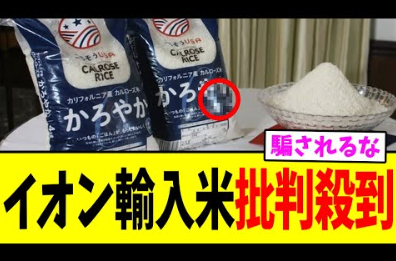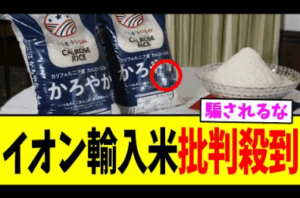【Shigeo’s Review】
Aeon announced that it will begin selling 100% American-imported rice, “Karoyaka,” in 600 stores nationwide starting June 2025, creating significant waves in the domestic rice market.
Aeon, which has traditionally focused on domestic rice, made this decision due to concerns over rice shortages and the high prices of domestic rice, which have been driving consumers away from rice and toward other staples like bread and pasta.
This decision has sparked mixed reactions, particularly strong criticism from farmers and supporters of domestic rice.
On one hand, the sale of imported rice by Aeon increases choices for consumers. Current rice prices in Japan are high, making it difficult for younger and low-income individuals to afford. If imported rice is offered at lower prices, it could lead to greater dietary diversity and alleviate household financial burdens.
However, the price of “Karoyaka” is set at 2,894 yen (tax included) for 4 kg, leading to online comments that suggest it is misleadingly priced; when converted to a 5 kg equivalent, it actually costs about 3,350 yen, which isn’t significantly cheaper. This could confuse consumers, highlighting the need for transparent price displays.
Conversely, farmers are responding with serious backlash. Although the rise in domestic rice prices is related to issues such as the monopolization by JA and increased production costs, domestic rice remains more expensive than imported rice. Continued distribution of imported rice could accelerate the decline of domestic agriculture.
Local farmers, in particular, have fragile business foundations and face a high risk of going out of business due to price competition with imported rice. Additionally, there is a strong national sentiment advocating for the protection of domestic rice, leading many to perceive Aeon’s decision as detrimental to farmers.
The government’s policies also influence this sale of imported rice. Unlike tax-free imports, private importation involves full taxes, seen as a temporary measure to address rice shortages and price hikes.
There are even conspiracy theories suggesting an intent to promote foreign rice at the expense of domestic agriculture. As a result, consumers express concerns about whether to increase the use of imported rice in home cooking, considering uncertainty about what type of rice is used in the food service industry.
Furthermore, the selling format raises concerns. “Karoyaka” is sold in 4 kg packages, potentially reducing the quantity compared to the traditional 5 kg packages in an attempt to enhance price competitiveness.
This strategy, seen as a clever manipulation of consumer psychology, has led to distrust, perceived as a “de facto price increase” or “betrayal of consumers.” Thus, Aeon’s foray into selling imported rice is not just a matter of price competition; it also undermines trust among both consumers and farmers.
In conclusion, Aeon’s sale of the imported rice “Karoyaka” has highlighted significant issues regarding Japan’s food policy and agricultural structure.
While there are certain price advantages for consumers, the impact on domestic agriculture and local food culture cannot be overlooked. Future policies will need to balance these aspects, including transparent price displays and enhanced support for domestic agriculture.
It is urgent for society to engage in deeper discussions and seek sustainable food supply systems.





